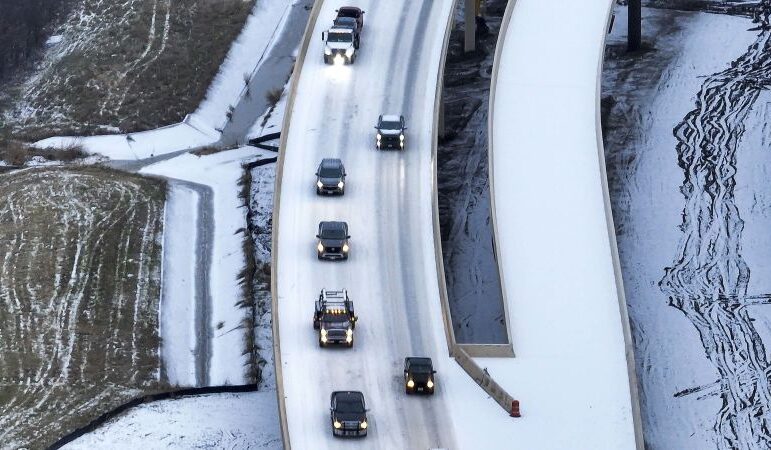Winter brings with it a unique set of challenges for drivers. Snow, ice, and cold temperatures can make the roads treacherous and increase the risk of accidents. But with the right knowledge, preparation, and cautious driving, you can navigate these conditions safely. In this blog post, we’ll provide you with valuable tips on how to avoid car accidents in winter weather conditions.
10 Tips to Avoid Winter Car Accidents
1. Prepare Your Vehicle
The first step to staying safe in winter weather is to make sure your vehicle is ready for the challenges ahead:
- Winter Tires: Investing in winter tires can greatly improve your vehicle’s traction on icy and snowy roads. These tires are designed with a different rubber compound that remains pliable in cold temperatures.
- Check Your Battery: Cold weather can be tough on your car’s battery. Make sure it’s in good condition and fully charged.
- Replace Worn-Out Wiper Blades: Good visibility is crucial during winter. Replace your wiper blades if they are streaking or not clearing your windshield properly.
- Keep Your Fuel Tank Full: Running out of gas in the bitter cold can be dangerous. Keeping your tank at least half full can help prevent this.
2. Slow Down and Increase Following Distance
One of the most important things you can do to avoid accidents in winter weather is to reduce your speed. Slippery conditions mean it will take longer to stop or slow down. Make sure to maintain a safe following distance, ideally three times the distance you would in dry conditions.
3. Drive Smoothly and Avoid Abrupt Movements
Sudden acceleration, braking, or steering can lead to a loss of control in icy conditions. Drive as smoothly as possible, and anticipate turns, stops, and lane changes well in advance.
4. Use Your Headlights
Visibility can be severely reduced during winter weather conditions, especially in snowstorms. Use your headlights to increase your visibility and make yourself more visible to other drivers. Regularly clean your headlights and taillights to ensure they are not covered with snow or ice.
5. Beware of Black Ice
Black ice is a nearly invisible layer of ice that forms on roads. It’s one of the most dangerous winter driving hazards. Be especially cautious on bridges, overpasses, and shaded areas, as these tend to freeze first.
6. Avoid Unnecessary Travel
Sometimes, the best way to avoid a car accident is simply not to drive in hazardous conditions. If you don’t need to be on the road during a snowstorm, stay home or find alternative means of transportation.
7. Keep an Emergency Kit
It’s important to be prepared for the worst. Keep an emergency kit in your car, including items like blankets, extra clothing, non-perishable food, water, a flashlight, a first-aid kit, and basic tools.
8. Know How to Handle a Skid
If you start to skid, remember not to panic. Take your foot off the accelerator and steer in the direction you want to go. Avoid over-correcting, which can make the skid worse.
9. Stay Informed
Keep an eye on the weather forecast and road conditions before you head out. Many websites and apps provide real-time updates on road conditions and traffic.
10. Drive Defensively
Even if you’re a cautious driver, others may not be. Always be on the lookout for erratic or aggressive drivers, especially in challenging conditions.
Car Accidents in Winter Statistics
Winter driving conditions are notoriously dangerous, and the statistics highlight just how hazardous this season can be, especially in Texas. According to the Texas Department of Transportation (TxDOT), over 30,000 crashes occur each year on icy, snowy, or slushy roads in Texas. In 2023, there were 4,500 reported accidents caused directly by icy road conditions, leading to multiple fatalities and serious injuries.
Here are some key statistics that show the increased risk during winter:
Texas experienced a 24% increase in accidents during icy conditions compared to other seasons. This rise is mainly due to drivers being unprepared for sudden weather changes.
During the 2022-2023 winter season, there were 142 fatalities in winter-related crashes across Texas, emphasizing the critical need for caution and preparedness.
Most winter accidents occur during early mornings when black ice is most prevalent and visibility is poor. Bridges, overpasses, and rural roads are particularly hazardous.
These statistics highlight the importance of staying vigilant and taking extra precautions when driving in winter weather conditions.
Are There More Car Accidents in Summer or Winter?
Comparing car accident rates between summer and winter reveals key differences in frequency and severity. During the summer, the total number of accidents is generally higher due to increased travel, distracted driving, and more vehicles on the road. However, avoiding car accidents in winter, although fewer, are often more severe due to slippery surfaces and poor visibility.
For example, in Texas, summer months account for about 20-30% more accidents compared to other seasons. Despite this, winter crashes are more likely to result in serious injuries or fatalities, particularly when drivers encounter black ice or snow-covered roads. Therefore, while summer might have more accidents overall, the risk level in winter is considerably higher due to the hazardous road conditions.
Conclusion
Winter weather conditions can be unforgiving, but with the right precautions and mindset, you can significantly reduce your risk of a car accident. Remember to prepare your vehicle, drive at a safe speed, and stay informed about road conditions. Above all, stay patient and considerate of other drivers. By following these tips, you’ll increase your chances of arriving at your destination safely, even in the harshest winter conditions.
Contact a Local Lawyer
If you were injured due to someone else’s negligence, contact our personal injury attorneys. Contact us today to schedule your free consultation and discuss your legal rights. We care and we can help.
Get in touch with us so we can evaluate your case for free. Call PMR Law at 832-844-6428 and a member of our team will get in touch with you immediately.
PMR Law is considered one of the Best Law Firms in America, by Rue Ratings. Several of our attorneys have been given the honor of being named Super Lawyers by Thomson Reuters. The American Institute of Personal Injury Attorneys has named our attorneys 10 Best in Client Satisfaction. Speaking of personal injury, Attorney and Practice Magazine awarded our attorneys with Top 10 Personal Injury Attorney distinctions. The National Trial Lawyers have named three of our attorneys as Top 100 attorneys.
The Academy of Attorneys has named two of our attorneys as Top 40 Under 40. Our attorneys have been recognized as Best Attorneys of America, by Rue Ratings. PMR Law is a proud member of the Multi-Million Dollar Advocate Forum. Houstonia Magazine has named two of our attorneys as Top Lawyers in Personal Injury. Forbes Advisor has recognized PMR Law attorneys in their Best Truck Accident Lawyers of Houston. Texas Lawyer magazine has named PMR Law as the #1 Personal Injury Law Firm in Houston.
Frequently Asked Questions Related to Avoiding Car Accidents In Winter
What season has the most car accidents?
Summer usually has more accidents due to increased travel, but winter crashes are often more severe because of ice, snow, and low visibility.
What should be included in a winter emergency car kit?
A well-prepared emergency car kit should include blankets, extra warm clothing, a flashlight, non-perishable snacks, bottled water, a first aid kit, jumper cables, tire chains, and a small shovel.
How do winter tires help prevent accidents?
Winter tires are designed with a special rubber compound and tread pattern that maintains flexibility in low temperatures. It also provides a better grip on snow and ice compared to regular tires.
Is it safe to use cruise control in winter weather?
No, cruise control should not be used on icy, snowy, or wet roads as it can lead to a loss of vehicle control.

